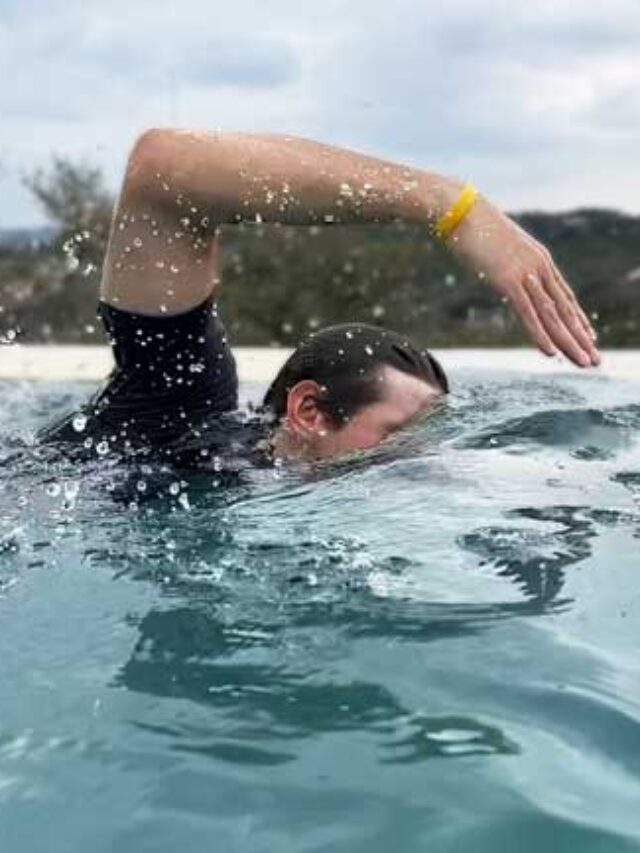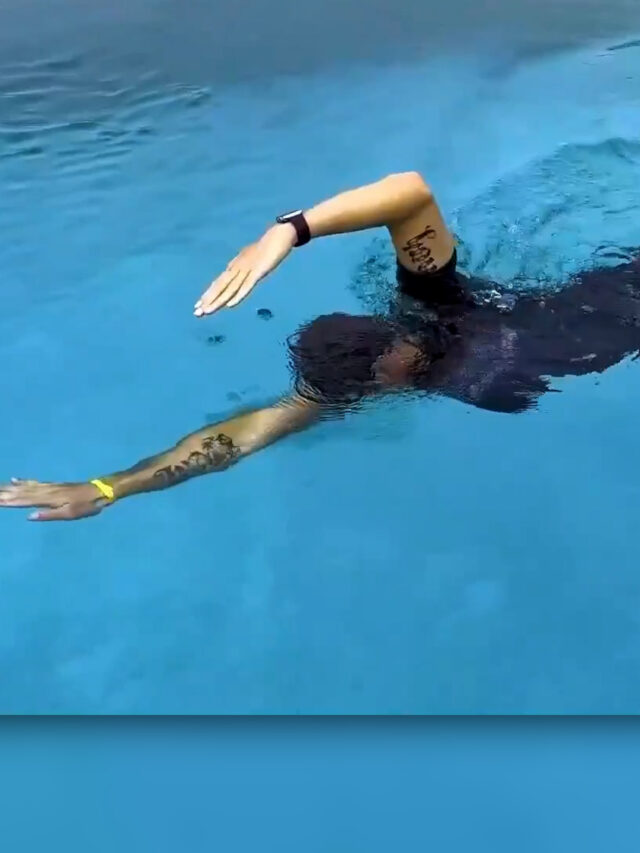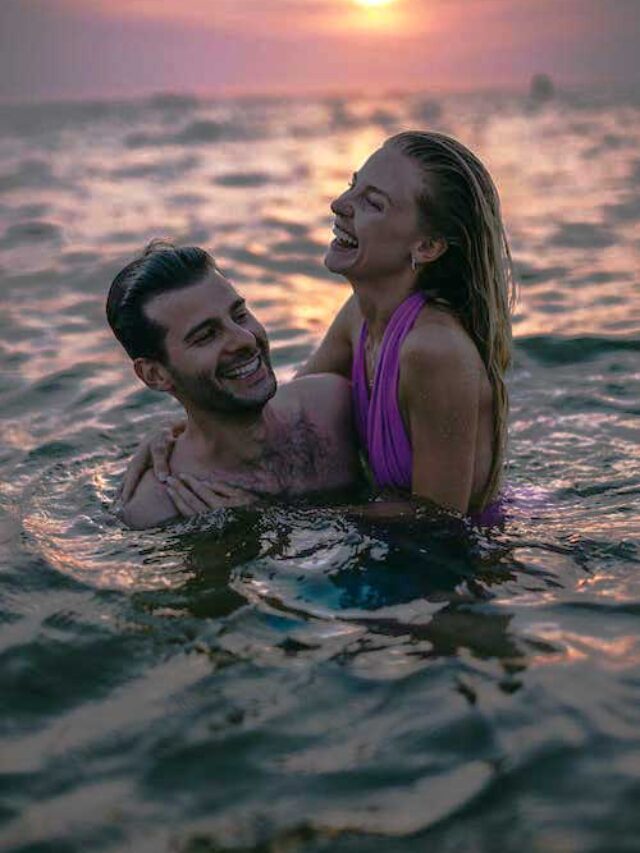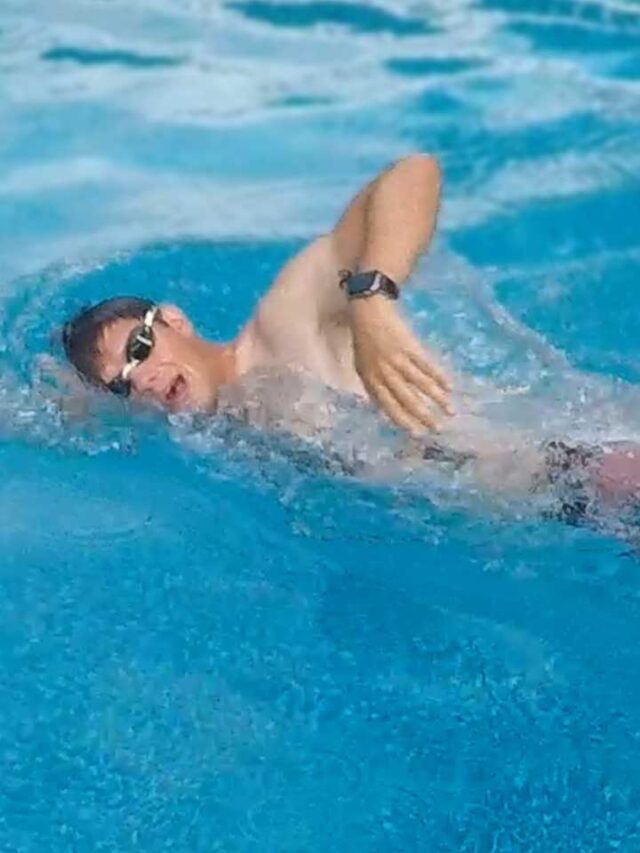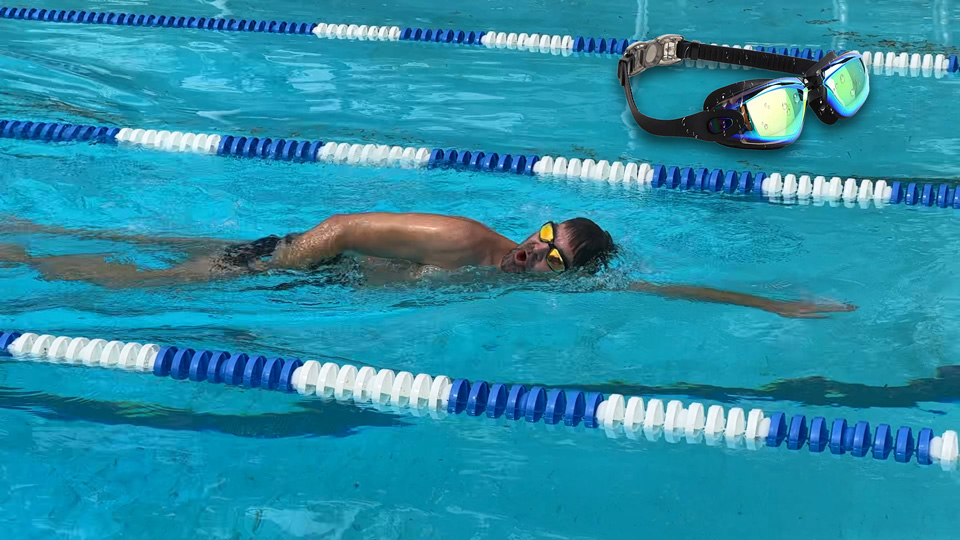
Swimming is a fantastic form of exercise that provides a low-impact, full-body workout. It’s a great way to improve cardiovascular fitness, strengthen muscles, and increase flexibility.
Whether you’re a beginner looking to get started with swimming or an experienced swimmer looking to mix up your workouts, you can try plenty of exercises and drills in the pool. This article will provide a range of swimming workouts and exercises for people of all fitness levels.
Warm-up exercises
Before diving into your swim workout, it’s important to warm up your muscles to prevent injury. A few simple exercises can help prepare your body for the rigors of swimming.
Some options include:
- Arm circles: Stand with your arms extended out to the sides, palms facing down. Slowly make circles with your arms in a forward motion for a few reps, then switch to a backward motion.
- Leg kicks: Stand with your arms at your sides and alternate lifting your knees up to your chest.
- Jumping jacks: In the shallow end of the pool, perform a few sets of jumping jacks to get your heart rate up.
Arm Circles
Arm circles are a simple but effective warm-up exercise that can be performed in the pool or on land. They help to stretch and loosen the muscles in the shoulders, arms, and upper back, preparing them for a swim workout or other physical activity.
To perform arm circles:
- Stand with your feet shoulder-width apart and your arms extended out to the sides, palms facing down.
- Begin making circles with your arms in a forward motion, using a slow and controlled movement. After a few reps, switch to a backward motion.
- Continue performing arm circles for 30 seconds to 1 minute, depending on your fitness level. You can also vary the size of the circles and the speed of the movement to challenge yourself.
Arm circles are a great way to get your blood flowing and your muscles warmed up before a swim workout. They can also be incorporated into your cool-down routine to stretch out the muscles after a workout.
Leg Kicks
Leg kicks are a simple but effective exercise that can be performed in the pool or on land to warm up the muscles in the legs and lower body. They are often used as part of a swimming warm-up routine, but they can also be incorporated into other types of workouts.
To perform leg kicks:
- Stand with your arms at your sides and your feet shoulder-width apart.
- Lift your right knee up towards your chest, then lower it back down. Repeat with your left leg.
- Continue alternating legs for a set of 10-15 reps, depending on your fitness level. You can also vary the speed and height of the kicks to challenge yourself.
Leg kicks can help to increase blood flow and loosen the muscles in the legs, preparing them for a swim workout or other physical activity. They can also be incorporated into your cool-down routine to stretch out the muscles after a workout.
As with any exercise, be sure to listen to your body and stop if you feel any pain or discomfort.
Jumping Jacks
Jumping jacks are a simple but effective cardio exercise that can be performed in the pool or on land. They involve jumping and spreading the legs and arms out to the sides, then bringing them back together.
Jumping jacks are a great way to get your heart rate up and warm up your muscles before a workout.
To perform jumping jacks:
- Stand with your feet together and your arms at your sides.
- Jump and spread your legs out to the sides, while simultaneously raising your arms above your head.
- Jump again and bring your legs and arms back together.
- Continue performing jumping jacks for a set of 10-20 reps, depending on your fitness level. You can also vary the speed and height of the jumps to challenge yourself.
Swimming workouts for different fitness levels
Whether you’re a beginner, intermediate, or advanced swimmer, there are workouts and exercises to suit your fitness level.
- Beginner: If you’re new to swimming, start with short, low-intensity workouts that focus on basic strokes. Try doing a few laps of freestyle or backstroke, taking breaks as needed. As you become more comfortable in the water, you can gradually increase the distance and intensity of your workouts.
- Intermediate: If you’re comfortable with the basic strokes and are looking to increase your endurance, try longer, moderate-intensity workouts that mix up the strokes. For example, you could do a few laps of freestyle, followed by a lap of breaststroke, then a lap of backstroke. You can also try using a kickboard or pull buoy to isolate different muscle groups and improve your technique.
- Advanced: If you’re an experienced swimmer looking for a challenge, try high-intensity workouts with intervals, sprints, and drills. For example, you could do a set of 50-meter sprints, followed by a set of 100-meter sprints, with a short rest in between. You can also incorporate drills like butterfly kick or catch-up freestyle to improve your speed and power.
Beginner Workouts
If you’re new to swimming or just starting to get back into it, it’s important to start slowly and build up your endurance and strength over time. Beginner swimming workouts should focus on basic strokes and be low-intensity to help you get comfortable in the water.
Here are a few ideas for beginner swimming workouts:
- Freestyle or backstroke laps: Start by swimming a few laps of freestyle or backstroke at a comfortable pace. Take breaks as needed, and gradually increase the distance and intensity of your workouts as you become more comfortable in the water.
- Stroke drills: Break down the different components of a stroke and focus on one aspect at a time. For example, you could work on your kick, arm pull, or breathing techniques. This can help you improve your technique and become more efficient in the water.
- Kick sets: Use a kickboard or buoy to isolate your legs and focus on your kick. You can also incorporate leg kicks or flutter kicks into your workouts to strengthen your leg muscles.
- Aquatic exercises: There are also a variety of exercises you can do in the pool to work on your strength and coordination. For example, you could try poolside push-ups or plank variations.
Remember to listen to your body and take breaks as needed. As you become more comfortable in the water and build up your endurance, you can gradually increase the intensity and variety of your workouts.
Swimming is a great way to get a low-impact, full-body workout, and with a little practice and patience, you’ll be swimming laps in no time!
Intermediate Workouts
If you’re comfortable with the basic strokes and are looking to increase your endurance and strength, intermediate swimming workouts are a great option. These workouts should be moderate-intensity and mix up the strokes to challenge your body in different ways.
Here are a few ideas for intermediate swimming workouts:
- Mix-and-match sets: Try doing a few laps of freestyle, followed by a lap of breaststroke, then a lap of backstroke. You can also mix in other strokes like butterfly or sidestroke to challenge yourself.
- Endurance sets: Increase the distance of your laps and aim to swim for a longer period of time. You can also incorporate interval training, where you swim at a harder pace for a set distance or time, followed by a shorter rest period.
- Stroke drills: Work on specific aspects of your stroke to improve your technique and efficiency in the water. For example, you could focus on your arm pull or kick, or try catch-up freestyle to work on your timing and coordination.
- Equipment training: Use equipment like kickboards, pull buoys, or swim fins to challenge different muscle groups and improve your technique.
As you become more comfortable with intermediate-level workouts, you can gradually increase the intensity and variety of your workouts. Swimming is a fantastic way to get a full-body workout and improve your endurance and strength.
With a little practice and patience, you’ll be swimming like a pro in no time!
Advanced Workouts
If you’re an experienced swimmer looking for a high-intensity challenge, advanced swimming workouts are a great option. These workouts should be focused on improving speed and power and may include intervals, sprints, and drills.
Here are a few ideas for advanced swimming workouts:
- Speed sets: Incorporate short sprints of 50-100 meters into your workouts, focusing on maintaining a fast pace and good technique. You can also try doing ladder sets, where you swim a series of increasing or decreasing distances (e.g., 50 meters, 100 meters, 150 meters, 100 meters, 50 meters).
- Drills: Work on specific aspects of your stroke to improve your technique and efficiency in the water. For example, you could try catch-up freestyle to work on your timing and coordination, or butterfly kick to improve your power and speed.
- Equipment training: Use equipment like kickboards, pull buoys, or swim fins to challenge different muscle groups and improve your technique.
- Race simulation: To prepare for a swim competition, try simulating a race in your workouts. This could include doing a set of sprints at race pace, or practicing starts and turns.
Remember to listen to your body and take breaks as needed. As an advanced swimmer, it’s important to push yourself and challenge your limits, but it’s also important to avoid overtraining and risking injury.
Swimming is a fantastic way to improve your speed and power, and with a little practice and dedication, you’ll be ready to take on any competition.
Targeted exercises for specific muscle groups
In addition to swimming laps, there are also exercises you can do in the pool to target specific muscle groups.
Upper body: To strengthen your chest, shoulders, and arms, try incorporating exercises like push-ups or dumbbell rows into your swim workouts. If you don’t have dumbbells, you can use pool noodles or other equipment to add resistance.
Lower body: To work your legs and core, try exercises like flutter kicks or leg presses. You can also use a kickboard to isolate your legs and perform exercises like Russian twists or bicycle kicks to work your core.
Upper Body Exercises
Incorporating upper body exercises into your swimming workouts is a great way to strengthen your chest, shoulders, and arms and improve your overall swimming performance.
Here are a few upper body exercises you can try in the pool:
- Push-ups: Place your hands on the edge of the pool and perform push-ups as you would on land. You can also try doing push-ups on a kickboard or noodle for added resistance.
- Dips: Using the edge of the pool or a diving block, perform dips to strengthen your triceps and chest.
- Dumbbell rows: If you have access to dumbbells, try performing bent-over rows or single-arm rows to strengthen your back and shoulder muscles.
- Tricep dips: Using the edge of the pool or a diving block, perform tricep dips to strengthen your triceps.
- Arm circles: As a warm-up or cool-down exercise, perform arm circles to stretch and loosen your shoulders and upper back.
As you become more comfortable with upper body exercises, you can gradually increase the intensity and variety of your workouts. Swimming is a fantastic way to strengthen your upper body and improve your overall swimming performance.
With a little practice and dedication, you’ll be well on your way to stronger, more powerful strokes.
Lower Body Exercises
Incorporating lower body exercises into your swimming workouts is a great way to strengthen your legs and core and improve your overall swimming performance.
Here are a few lower body exercises you can try in the pool:
- Flutter kicks: Using a kickboard or floating on your back, perform flutter kicks to strengthen your legs and improve your kick. You can also try incorporating leg kicks or scissor kicks into your workouts.
- Leg presses: Place your feet on the edge of the pool and perform leg presses to strengthen your quadriceps and glutes. You can also try using a kickboard or noodle for added resistance.
- Russian twists: Using a kickboard or floating on your back, perform Russian twists to strengthen your obliques and improve your core stability.
- Bicycle kicks: Using a kickboard or floating on your back, perform bicycle kicks to strengthen your obliques and lower back.
- Aquatic lunges: Perform lunges in the shallow end of the pool to strengthen your legs and improve your balance.
As you progress and become more comfortable with lower body exercises, you can gradually increase the intensity and variety of your workouts. Swimming is an excellent way to strengthen your lower body and improve your overall swimming performance.
With consistent practice and dedication, you can achieve stronger and more powerful strokes.
Cool-down exercises
After completing your swim workout, it’s important to cool down and stretch out your muscles to prevent injury and improve flexibility.
Cool-down exercises are an essential part of any workout routine, as they help to gradually lower your heart rate and stretch out your muscles. Cool-down exercises should be low-intensity and focus on stretching and relaxation. Here are a few cool-down exercises you can try after a swim workout:
A few options for cool-down exercises include:
- Stretching: Hold each stretch for 30 seconds, focusing on muscles like your calves, hamstrings, and quadriceps.
- Yoga poses: Try poses like downward-facing dog or child’s pose to stretch out your entire body.
- Foam rolling: Use a foam roller to massage out tight muscles, particularly in your back and legs.
Swimming is a fantastic form of exercise that provides a low-impact, full-body workout. It’s a great way to improve cardiovascular fitness, strengthen muscles, and increase flexibility.
Whether you’re a beginner looking to get started with swimming or an experienced swimmer looking to mix up your workouts, there are plenty of exercises and drills you can try in the pool. Remember to always warm up before your swim workout and cool down afterwards, and don’t be afraid to try out different workouts and exercises to find what works best for you.
If you’re interested in learning to swim or improving your swimming skills, private swimming lessons are a great option. Private lessons offer one-on-one instruction with a certified swim instructor, allowing you to progress at your own pace and focus on your specific goals.
Private lessons are also a great option for people who may feel self-conscious or nervous about learning to swim in a group setting
We hope you’ve found this article on swimming workouts and exercises helpful. If you enjoyed it, we encourage you to share it with your friends and family on social media.
You can also check out our YouTube channel, which has a wide range of how-to-swim videos and other swimming-related content. Happy swimming!
Happy swimming!


